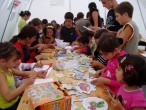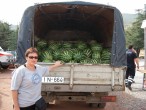Relief Mission in Georgia
In August 2008, following a summer of tension and increased military incidents, Georgia launched a large-scale military offensive to reclaim the territory of South Ossetia from Russia. The situation deteriorated further with renewed fighting in the Georgian breakaway province of Abkhazia, as well as fighting in other parts of Georgia, specifically in the Gori region.
The fighting led to both internal and external displacement of large numbers of people, as well as serious violations of human rights on both sides, and some 30,000 Georgians became refugees. The conflict greatly impacted the civilian population and put great strain on the capacities of the government and humanitarian organizations to respond. Georgia was already a country with some hundreds of thousands displaced persons from previous conflicts in the regions of South Ossetia and Abkhazia. Most of those displaced by the fighting were located in and around the capital, Tbilisi, residing in collective centers that were established for the previously existing caseload, or in new rapidly established sites. This multiplication of sites for displaced people presented both government and aid agencies with difficulties in locating them, identifying their needs, and ensuring that aid was delivered.
Along with members from the Israeli Coalition for Relief Operations (IRelief), the Embassy of Georgia in Israel and the Israeli Foreign Ministry, Brit Olam organized a relief operation to aid the victims of the Georgian crisis. The operation addressed the needs of the refugees.
 Primarily, the delegation operated a humanitarian relief operation in the main displaced people’s camp in the city of Gori in Georgia. The delegation consisted of volunteers who were experts in the fields of psycho-trauma, art therapy, medicine, education and institutional reconstruction.
The delegation’s work focused on four main areas:
• Implementing a wide variety of programs in the field of psycho-trauma for refugees who resided in the camp, as well as in the larger Gori vicinity; in schools and in education, health and social welfare institutions, providing training to local therapists whose communities were affected by the war.
• Implementing programs for refugee children and youth in an improvised youth center set up by the volunteers in cooperation with local agents.
• Providing medical aid through international medical units operating in the field, including recruitment of equipment and resources for a women and children’s hospital in the Gori vicinity.
Primarily, the delegation operated a humanitarian relief operation in the main displaced people’s camp in the city of Gori in Georgia. The delegation consisted of volunteers who were experts in the fields of psycho-trauma, art therapy, medicine, education and institutional reconstruction.
The delegation’s work focused on four main areas:
• Implementing a wide variety of programs in the field of psycho-trauma for refugees who resided in the camp, as well as in the larger Gori vicinity; in schools and in education, health and social welfare institutions, providing training to local therapists whose communities were affected by the war.
• Implementing programs for refugee children and youth in an improvised youth center set up by the volunteers in cooperation with local agents.
• Providing medical aid through international medical units operating in the field, including recruitment of equipment and resources for a women and children’s hospital in the Gori vicinity.
 • Purchasing fresh vegetables and fruits for residents of the camp, thus enriching the IDP’s nutrition and supporting the local markets.
The delegation’s activities were highly acclaimed by leaders in the Georgian government, including the area governor, the Minister for Humanitarian Affairs, the Georgian Minister of Health, and other agencies that operated in the area. The delegation operated in cooperation with a number of humanitarian organizations, including the UNHCR, the World Food Program, the International Red Cross, the Georgian Red Cross and members from IRelief, the Embassy of Georgia in Israel, the Israeli Foreign Ministry and others.
Brit Olam’s delegation served hundreds of children, youth, women and their families in the Gori main refugee camp. Activities included dance and other recreational activities which were also attended by youth from Gori thus integrating local youth and refugee youth. Brit Olam invested most of its’ efforts in training teachers, youth facilitators and social workers (which there were not many of) to ensure that activities, especially adapted to the local needs, were sustained. As the only Israeli organization that worked in the area for a total period of three months, Brit Olam was warmly welcomed by the small local Jewish community of Gori.
• Purchasing fresh vegetables and fruits for residents of the camp, thus enriching the IDP’s nutrition and supporting the local markets.
The delegation’s activities were highly acclaimed by leaders in the Georgian government, including the area governor, the Minister for Humanitarian Affairs, the Georgian Minister of Health, and other agencies that operated in the area. The delegation operated in cooperation with a number of humanitarian organizations, including the UNHCR, the World Food Program, the International Red Cross, the Georgian Red Cross and members from IRelief, the Embassy of Georgia in Israel, the Israeli Foreign Ministry and others.
Brit Olam’s delegation served hundreds of children, youth, women and their families in the Gori main refugee camp. Activities included dance and other recreational activities which were also attended by youth from Gori thus integrating local youth and refugee youth. Brit Olam invested most of its’ efforts in training teachers, youth facilitators and social workers (which there were not many of) to ensure that activities, especially adapted to the local needs, were sustained. As the only Israeli organization that worked in the area for a total period of three months, Brit Olam was warmly welcomed by the small local Jewish community of Gori.
 Primarily, the delegation operated a humanitarian relief operation in the main displaced people’s camp in the city of Gori in Georgia. The delegation consisted of volunteers who were experts in the fields of psycho-trauma, art therapy, medicine, education and institutional reconstruction.
The delegation’s work focused on four main areas:
• Implementing a wide variety of programs in the field of psycho-trauma for refugees who resided in the camp, as well as in the larger Gori vicinity; in schools and in education, health and social welfare institutions, providing training to local therapists whose communities were affected by the war.
• Implementing programs for refugee children and youth in an improvised youth center set up by the volunteers in cooperation with local agents.
• Providing medical aid through international medical units operating in the field, including recruitment of equipment and resources for a women and children’s hospital in the Gori vicinity.
Primarily, the delegation operated a humanitarian relief operation in the main displaced people’s camp in the city of Gori in Georgia. The delegation consisted of volunteers who were experts in the fields of psycho-trauma, art therapy, medicine, education and institutional reconstruction.
The delegation’s work focused on four main areas:
• Implementing a wide variety of programs in the field of psycho-trauma for refugees who resided in the camp, as well as in the larger Gori vicinity; in schools and in education, health and social welfare institutions, providing training to local therapists whose communities were affected by the war.
• Implementing programs for refugee children and youth in an improvised youth center set up by the volunteers in cooperation with local agents.
• Providing medical aid through international medical units operating in the field, including recruitment of equipment and resources for a women and children’s hospital in the Gori vicinity.
 • Purchasing fresh vegetables and fruits for residents of the camp, thus enriching the IDP’s nutrition and supporting the local markets.
The delegation’s activities were highly acclaimed by leaders in the Georgian government, including the area governor, the Minister for Humanitarian Affairs, the Georgian Minister of Health, and other agencies that operated in the area. The delegation operated in cooperation with a number of humanitarian organizations, including the UNHCR, the World Food Program, the International Red Cross, the Georgian Red Cross and members from IRelief, the Embassy of Georgia in Israel, the Israeli Foreign Ministry and others.
Brit Olam’s delegation served hundreds of children, youth, women and their families in the Gori main refugee camp. Activities included dance and other recreational activities which were also attended by youth from Gori thus integrating local youth and refugee youth. Brit Olam invested most of its’ efforts in training teachers, youth facilitators and social workers (which there were not many of) to ensure that activities, especially adapted to the local needs, were sustained. As the only Israeli organization that worked in the area for a total period of three months, Brit Olam was warmly welcomed by the small local Jewish community of Gori.
• Purchasing fresh vegetables and fruits for residents of the camp, thus enriching the IDP’s nutrition and supporting the local markets.
The delegation’s activities were highly acclaimed by leaders in the Georgian government, including the area governor, the Minister for Humanitarian Affairs, the Georgian Minister of Health, and other agencies that operated in the area. The delegation operated in cooperation with a number of humanitarian organizations, including the UNHCR, the World Food Program, the International Red Cross, the Georgian Red Cross and members from IRelief, the Embassy of Georgia in Israel, the Israeli Foreign Ministry and others.
Brit Olam’s delegation served hundreds of children, youth, women and their families in the Gori main refugee camp. Activities included dance and other recreational activities which were also attended by youth from Gori thus integrating local youth and refugee youth. Brit Olam invested most of its’ efforts in training teachers, youth facilitators and social workers (which there were not many of) to ensure that activities, especially adapted to the local needs, were sustained. As the only Israeli organization that worked in the area for a total period of three months, Brit Olam was warmly welcomed by the small local Jewish community of Gori.
Copyright © 2022 Brit Olam